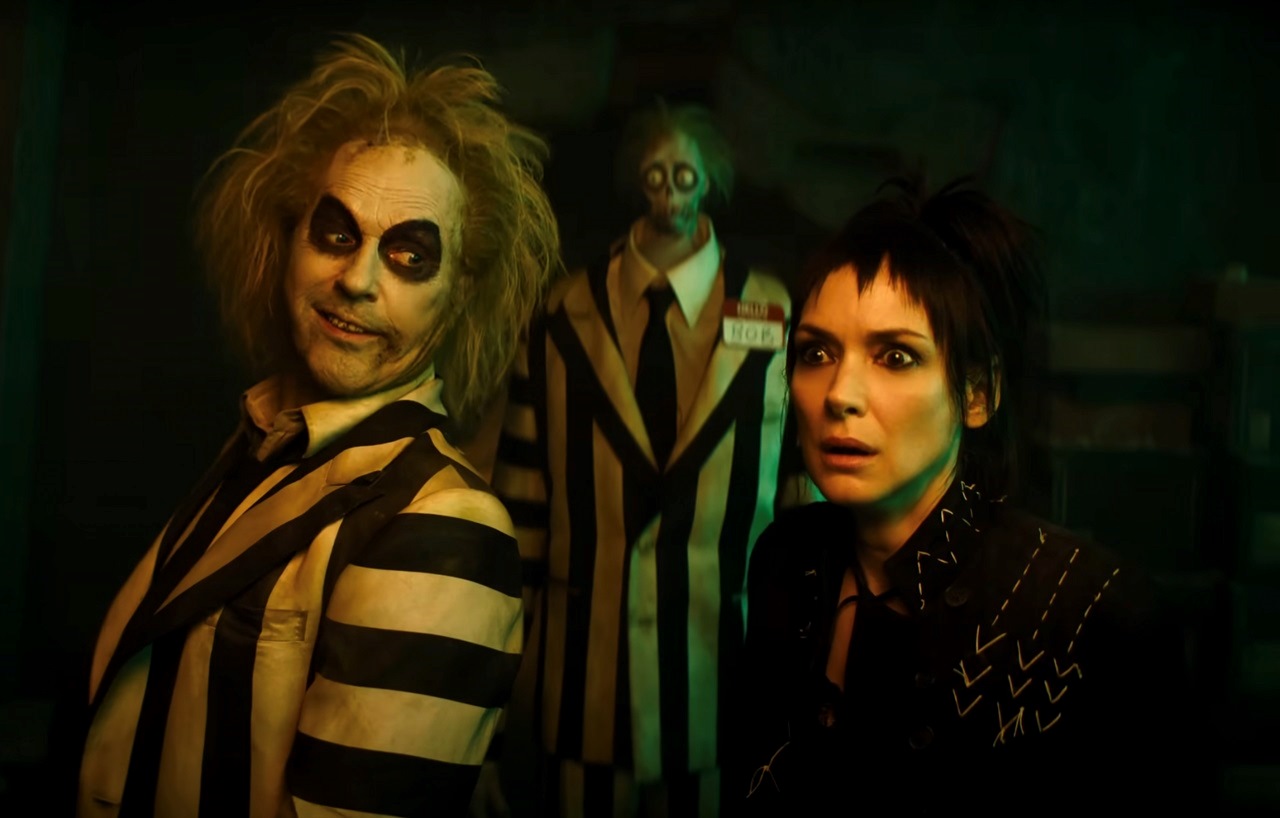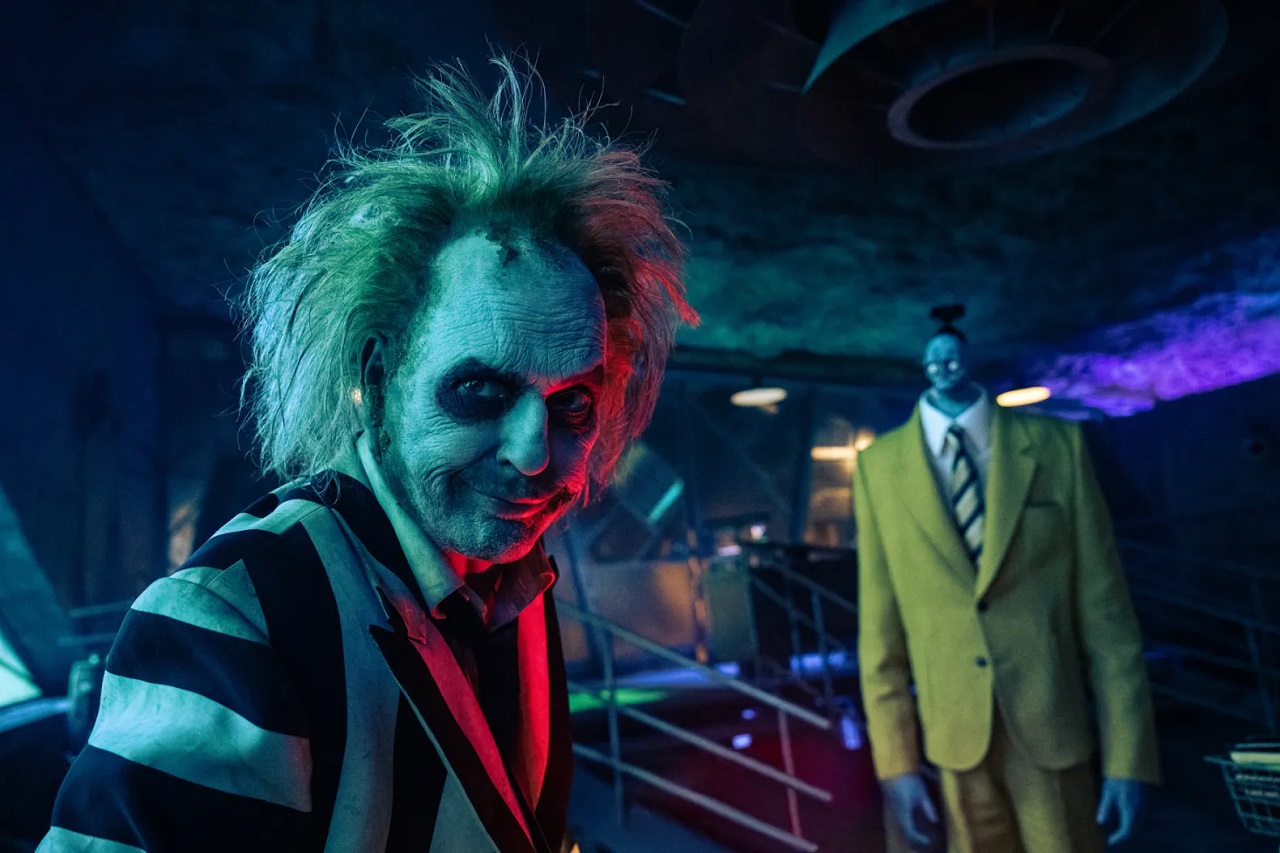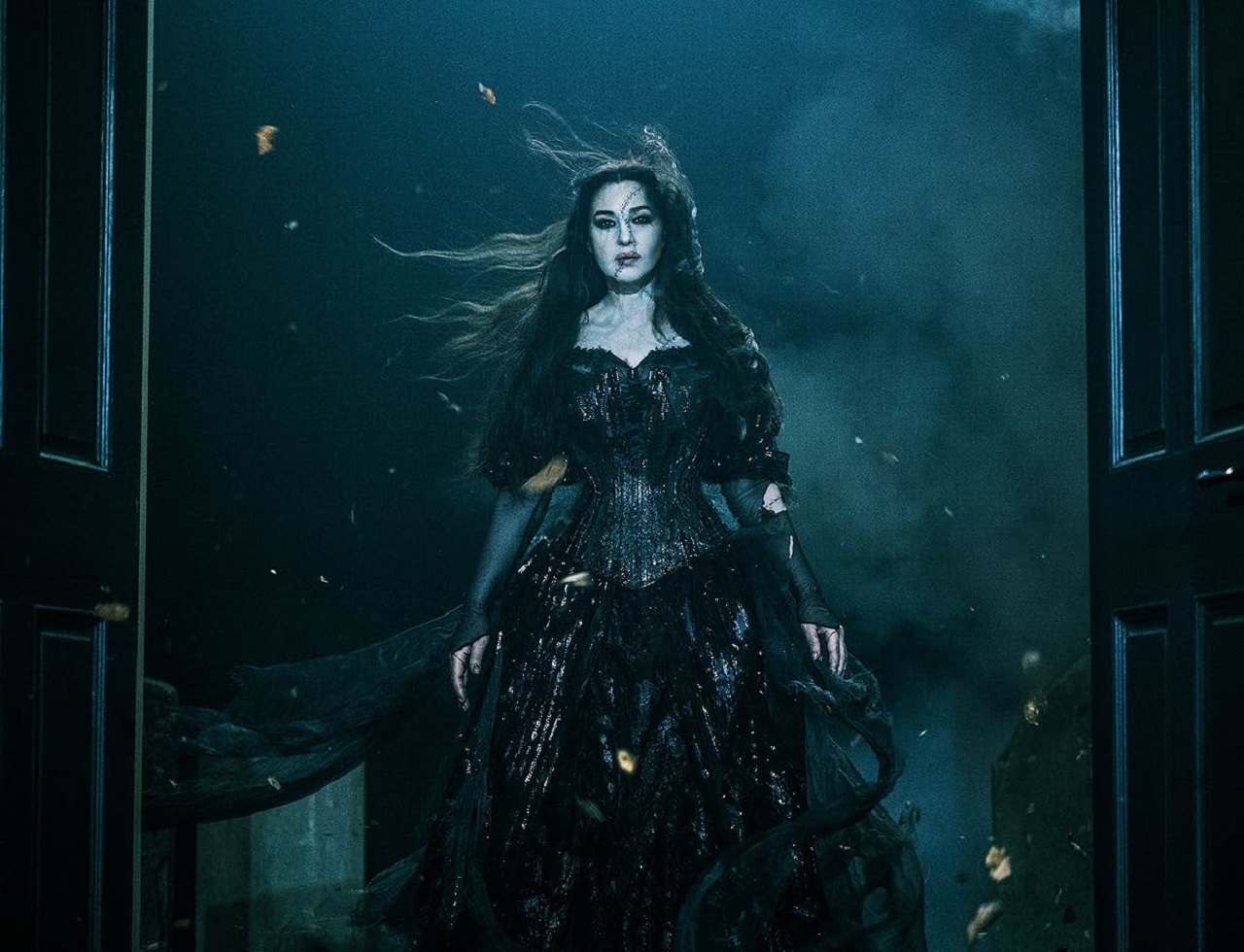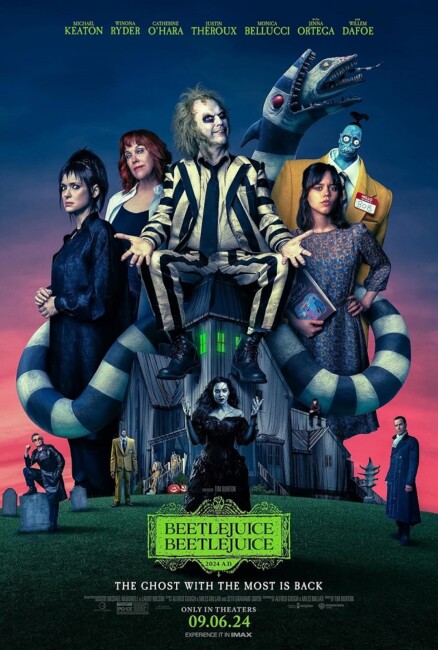USA. 2024.
Crew
Director – Tim Burton, Screenplay – Alfred Gough & Miles Millar, Story – Alfred Gough, Seth Grahame-Smith & Miles Millar, Producers – Tim Burton, Dede Gardner, Tommy Harper, Jeremy Kleiner & Marc Toberoff, Photography – Harris Zambarloukos, Music – Danny Elfman, Visual Effects Supervisor – Angus Bickerton, Visual Effects – Buf VFX (Supervisors – Geoffrey Nicquet, Stephane Vogel & Mingyang Zhao), Framestore (Supervisor – Matt Krentz), Goldcrest VFX, One of Us (Supervisor – James Brennan-Craddock) & Red VFX (Supervisor – Lev Kolobov), Special Effects Supervisor – Sefano Pepin, Animatronic/Makeup Effects Supervisor – Neal Scanlan, Production Design – Mark Scruton. Production Company – Tim Burton/Tom Harper/Plan B Entertainment/Marc Toberoff.
Cast
Winona Ryder (Lydia Deetz), Michael Keaton (Beetlejuice), Catherine O’Hara (Delia Deetz), Jenna Ortega (Astrid Deetz), Justin Theroux (Rory), Monica Bellucci (Delores), Willem Dafoe (Wolf Jackson), Arthur Conti (Jeremy Frazier), Burn Gorman (Father Damien), Nick Kellington (Bob-Shrinker), Santiago Cabrera (Richard), Danny DeVito (Janitor)
Plot
Lydia Deetz has become the host of a successful tv show Ghost House with her ability to see ghosts. She then receives news from her mother Delia that her father Charles has died, eaten by sharks following a plane crash at sea. They take the news on to Lydia’s daughter Astrid who is at university, but is dismissive of her mother’s belief in ghosts. The funeral is held but this is upstaged by Lydia’s boyfriend Rory who proposes to her. Lydia agrees to a wedding to be held on Halloween in two days. Meanwhile, in the afterlife, Delores, the woman who married and then poisoned Beetlejuice when he was alive, gathers her severed pieces together and comes searching for him, sucking out the souls of all in her way. Lydia keeps seeing Beetlejuice everywhere and locks the attic, forbidding Astrid to go in or say Beetlejuice’s name. Astrid meets a boy Jeremy, but in the course of doing so is tricked into signing a contract where she will take the place of a dead person in the afterlife. In desperation, Lydia calls Beetlejuice’s name and agrees to marry him if he will help save Lydia from getting on the Soul Train.
Beetlejuice (1988) was the second film from Tim Burton. His first film Pee-Wee’s Big Adventure (1985) had received acclaim but its appeal was more as a cult film than a widespread audience. Beetlejuice however was given a wide release. Nobody quite knew what to make of Burton’s wacky visuals and the gonzo design schemes – there was nothing had been seen on screen like it before. Audiences clearly loved what they were seeing and Beetlejuice was the tenth highest grossing film of the year.
Tim Burton went on to a strings of hits over the next few years that included Batman (1989), Edward Scissorhands (1990), Batman Returns (1992), The Nightmare Before Christmas (1993) and Ed Wood (1994). These propelled him to become one of the most distinctive and quirky voices in fantastic cinema throughout the decade. By around the mid-1990s though, something happened and Burton lost his mojo. People may debate exactly when but his output since the 2000s has been lacking in the same creative verve that his work from 1985 to 1994 has. This period has included the lesser likes of Sleepy Hollow (1999), Planet of the Apes (2001), Big Fish (2003), Charlie and the Chocolate Factory (2005), Sweeney Todd: The Demon Barber of Fleet Street (2007), Alice in Wonderland (2010), Dark Shadows (2012), Frankenweenie (2012), Big Eyes (2014), Miss Peregrine’s Home for Peculiar Children (2016) and Dumbo (2019).
A sequel to Beetlejuice has been planned since at least the early 1990s. There was a script floating around for a long time called Beetlejuice Goes Hawaiian/Beetlejuice Goes to Hawaii. Variants on it kept resurfacing every few years. Names like Kevin Smith and Seth Grahame-Smith, the novelist who had a hit with the genre mash-ups Pride and Prejudice and Zombies (2009) and Abraham Lincoln, Vampire Hunter (2010) were floated around. Grahame-Smith receives co-story credit, while the actual script is handled by the writing duo of Alfred Gough and Miles Millar who created the tv series Smallville (2001-11) and wrote Shanghai Noon (2000). Among the unusual names on the credits is that of executive producer Brad Pitt and his Plan B production company.

Beetlejuice Beetlejuice finally arrives on the screen 36 years after the original came out. It is hard not to cynically see it as being yet another IP of the past that has been scoured and resurrected for a few more dollars. It is an odd case of a work being positioned at almost the opposite ends of people’s careers. In 1988, it was the work that set a largely unknown Tim Burton on the map. By the 2000s, a 66 year-old Burton has become a brand name and has been coasting by for some time, where he confessed that he was considering retirement before deciding to make Beetlejuice Beetlejuice. Similarly, Beetlejuice put a seventeen year-old Winona Ryder on the map and made her a Goth icon, whereas by the time of the sequel, a 52-year-old Ryder is now in the midst of a career second wind following tv’s Stranger Things (2016-25).
Expectedly, Beetlejuice Beetlejuice revisits the familiar. There are return visits to the house and attic with the model that comes to life. There is a return to the afterlife waiting room and a more expanded tour of the afterlife. Michael Keaton works in a office peopled by shrunken head attendees. There is a return of the snake in the desert. Cameos of Alec Baldwin and Geena Davis were considered but Burton dismissed the idea due to the impossibility of de-aging them. About the one thing we don’t get is a return of Jeffrey Jones – although his photo is seen on the gravestone – due to the fact that Jones is on the sex offenders list since a 2002 arrest for soliciting a fourteen-year-old boy to pose for nude photos – while the character of Otho is simply written out in that Glenn Shadix passed away in 2010.
The plot seems to be set up to follow some of the original, particularly when it comes to Jenna Ortega’s character doing a repeat of Winona Ryder in the original. That doesn’t quite turn out to be the case. Jenna’s Astrid does get a surprise character twist pulled on her in the middle of the film, which pulls the carpet out with some effect. And there is some effort put in to exploring Beetlejuice’s life and complications, although this serves to make him a much cuddlier figure.

The latter half of the show sits unevenly between Beetlejuice as redeemably obnoxious hero and the same old threat he posed in the original. The plot has Lydia conducting a devil’s deal to agree to marry Beetlejuice to save her daughter but then pulls a real deus ex machina twist to let her off the hook. On the other hand, the film goes out on an ending [PLOT SPOILERS] where mother and daughter seem to go on to a happy life together before Jenna Ortega seems to give birth to a baby Beetlejuice, but this to prove to be a nightmare being had by Winona Ryder who wakes up in a bed with Beetlejuice. For the cute cuddly kooky fantasy that Beetlejuice Beetlejuice sets out to be, it is an ending that leaves a sour aftertaste.
As evidenced by the ending, there unfortunately seem to be times that Tim Burton is no longer even trying. There is still nothing to the sequel that has the utter outlandishness that the original did in scenes like where a group of diners are possessed for a rendition of Day-O. (The song itself gets repeated here at Charles’s funeral but, symptomatic of how watered down the sequel is, all we gets is a children’s choral version). Beetlejuice gets a flashback origin story – which seems to be channelling Addams Family sensibilities – but it is a sequence with so little invested in it, you just shrug it off for its stylistic weirdness (shot in black-and-white, told in subtitled Italian). You never, for example, work out why Delores is so obsessed with Beetlejuice.
The kooky afterlife sets and denizens were one of the highlights of Beetlejuice but the sequel seems to be operating on a lower budget. This becomes a problem in that far more of a percentage of the film is set in the afterlife and thus dependent on not just showing the waiting room but visiting various offices, train stations, storage rooms and the like. It becomes evident after a time that costs are being cut on the sets, particularly some of the corridors that trail off into perspective, which look exactly like they are painted flats. Willem Dafoe’s exposed brain like just like a rubber Halloween appliance. The afterlife waiting room is the same eccentric place, although we do get more in the way of bizarre accident victims – ones being eaten by cats and fish, impaled by javelins, trapped in escapology boxes, Charles walking around as the bottom half of a body that has been bitten in half by a shark, and the like.

There are times that Beetlejuice Beetlejuice occasionally hits the mark that the original did. Louis Theroux embodies some of the obnoxiousness that the Deetz’s represented in the original. (Delia’s gauche tackiness has just become another weirdly cuddly aspect this time around). And certainly, when Michael Keaton gets back into the scene proper, he has a field day, especially when it comes to the wedding scene that climaxes the film. For some reason, the film seems to want to lay into a whole lot of therapyspeak – Beetlejuice literally “spills his guts” and has an actual inner child.
Alfred Gough and Miles Millar have written other screenplays for Spider-Man 2 (2004), Herbie: Full Loaded (2005), the tv pilot Aquaman (2007), The Mummy: Tomb of the Dragon Emperor (2008) and I Am Number Four (2011) and the tv series Into the Badlands (2015-9) and The Shannara Chronicles (2016-7), as well as created Burton’s most recent film project, the tv series Wednesday (2022- ).
Seth Grahame-Smith had his two most famous novels adapted to the screen – Tim Burton produced the film version of Abraham Lincoln, Vampire Hunter (2012), while there was also the adaptation of Pride and Prejudice and Zombies (2016). Grahame-Smith also wrote Dark Shadows for Burton, along with The Lego Batman Movie (2017) and has produced It (2017), The Lego Ninjago Movie (2017), Child’s Play (2019) and It: Chapter Two (2019), as well as created the R.L. Stine tv series Just Beyond (2021- ).
Trailer here
And here

